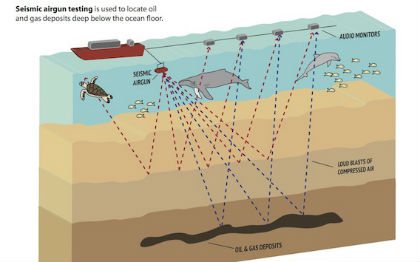Any time an oil or gas company drills for energy reserves, it is speculative; modern technology, however, has significantly reduced the guesswork in siting oil and gas rigs.

The most accurate, and controversial, means of determining if petroleum reserves exist is a geological and geophysical survey. Those in the business call it G&G; the rest of us refer to them as seismic surveys. Advances in G&G technology have dramatically increased the oil industry’s ability to locate oil and natural gas.
Supporter Spotlight
Ships towing an array of “air guns” transit a grid pattern on the ocean. The guns emit a very low frequency but loud blast of sound directed at the seabed. Because the sound waves are very long – lower frequencies have longer waves – they can penetrate deep into the earth’s crust. As the sound rebounds, the data is analyzed and a map of the substrata of the ocean up to 10,000 feet below the surface can be created.
G&G surveys do not mean drilling is imminent, and the permitting for a G&G survey is completely separate from the lease-sale process. Nonetheless, it is an important part of the search for petroleum reserves. Private companies will develop maps of the seabed substrata and sell that information to oil companies.
It is a controversial means of mapping the seabed. Marine biologists have pointed out that whales, dolphins, porpoises, turtles and almost all marine mammals and reptiles navigate and communicate using sound. The blasts of sound emitted from the air guns have the potential to damage the hearing of marine animals.
Although there have been coincidental reports of injured and dead marine mammals during seismic surveying, proponents of the method point out that there have been no peer-reviewed studies establishing a link.
Because of potential harm to marine life, the federal government requires an Incidental Harassment Authorization within the G&G permitting process. The authorization requires the company seeking the permit to have a mitigation plan in place to avoid or minimize contact with marine life. Typically that includes having a spotter on the survey ship and generally requiring a 500-meter buffer zone between the use of an air gun and any marine mammals or sea turtles.
Supporter Spotlight
Ten companies have applied to the Bureau of Ocean Energy Management, or BOEM, to conduct seismic tests in the Atlantic. Four want to test off the N.C. coast. Because the G&G activity will be occurring beyond the three-mile state zone, companies seeking a BOEM permit do not need a state permit. They are required, however, to have a consistency review under the state’s Coastal Zone Management Act.
The state has so far approved three applications.







